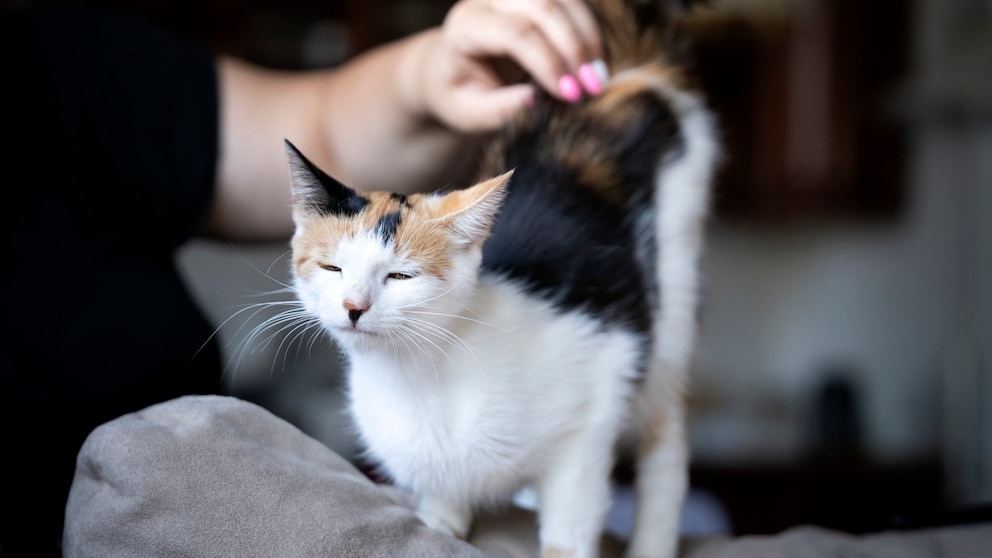March 16, 2025, 9:51 am | Read time: 5 minutes
Cats are fascinating creatures with their own preferences when it comes to being stroked. While some enjoy being gently stroked on the head or under the chin, others react particularly positively when they are lightly patted on the back or the base of the tail. But why is that?
Many cat owners know this behavior well: the cat blissfully turns around, raises its hindquarters, and seeks affectionate strokes. But for some cats that’s not enough, they want more. Take my cat, Archie, for instance, who adores a firmer stroke and pat on his hindquarters. But where does this unusual preference come from? Why do many cats enjoy having their bottoms patted and being stroked intensively? The answer lies in a mixture of biological, social, and behavioral factors.
The Base of the Tail — a Sensitive Area
The region just above the base of the tail ranks among the most sensitive areas on a cat’s body. There are a particularly large number of nerve endings here, which makes touch in this region more intensely perceptible for the cat. A gentle tap there can feel like a pleasant massage. Cats also have a high density of sebaceous glands in this area. These glands produce pheromones, which play an important role in territory marking and social communication.
As the area around the base of the tail is highly innervated and important for communication, many cats react particularly intensely to being touched there — either with pleasure or with irritation if it becomes too much.
Instinctive Memories of Mother Care
Young kittens are not only fed by their mothers but also licked and groomed intensively. The region around the base of the tail, in particular, is often cleaned by mother cats to stimulate the kittens’ digestion and elimination. This early childhood experience can remain deeply anchored in a cat’s behavior. Some cats associate touch in this area with the security and care they experienced as kittens.
Adult cats also groom each other (allogrooming), often focusing on the back, the rear part of the body, and the bottom. If a cat enjoys these touches, it may feel reminded of social interactions with conspecifics.
Cats that are very social and people-oriented may, therefore, perceive it as a sign of affection when their owner strokes or pats their bottom.
Cats Enjoy Having Their Bottoms Patted as a Form of Communication and Proof of Trust
Cats typically express their emotions in subtle ways, and their behaviors may not be immediately apparent. A cat’s relaxed acceptance of gentle pats on the bottom can signify a profound trust.
Typical behaviors that indicate a cat’s pleasure:
- The cat lifts its rear end further to intensify the touch.
- It purrs or rubs itself against its human.
- It turns in a pleased manner or demands more attention by nuzzling or nudging.
Hormonal and Instinctive Reactions
Another explanation for this behavior lies in the cat’s natural instincts and hormones. In female cats, in particular, tapping their bottom can trigger a reflex behavior that is related to their readiness to mate. When they are in heat, they often adopt a certain posture in which they lift their rear end and lay their tail to one side. This posture — known as lordosis — signals their readiness to mate.
However, neutered cats or males can also exhibit this behavior if they find patting and stroking the back of the back or the base of the tail a pleasant stimulation.
The Right Technique
Not all cats appreciate pats on their hindquarters, and even the enthusiasts have distinct preferences. The right technique and intensity are crucial to giving your cat a pleasurable experience.
It is important to pay attention to the cat’s body language. If the cat shows signs of enjoyment, such as purring, rubbing, or lifting its rear end, you can continue. However, if the cat shows irritation, it’s best to cease the activity.
Start with light touches or gentle taps, and only increase the intensity if your cat obviously enjoys it. Some cats only like it for a few seconds, while others can enjoy it for longer, so you should also pay attention to the length of time you do it.
Many cats also enjoy it when tapping is combined with back or head-scratching. An effective test is to gently glide your fingertips down the cat’s back and watch to see if it presents or shies away from the rear area.

Pay attention to signals Almost everyone makes these mistakes when petting cats

Behavior explained Cats bite when stroked for these 4 reasons

Behavior explained Why do cats show us their bottoms?
How Do Cats Show When They Don’t Like Having Their Bottoms Patted
Not all cats react positively to being patted or having their bottom scratched. Indicators that a cat is no longer comfortable or has had its fill include
- Twitching or whipping of the tail.
- Sudden change of direction or walking away.
- Hissing, growling, or even playful nipping.
Cats have different personalities and preferences. While some love being patted in this area, others may find it unpleasant.
Conclusion: For many cats, having their bottoms patted or scratched is a pleasurable experience that can be explained by a combination of sensitive nerve endings, social interactions, and instinctive reactions. While some cats actively demand and enjoy this, there are also those who are sensitive or irritable to it.
The key lies in identifying and respectfully accommodating your cat’s unique preferences. If your cat likes tapping, it can be a wonderful way to strengthen your bond with them and promote their well-being.

